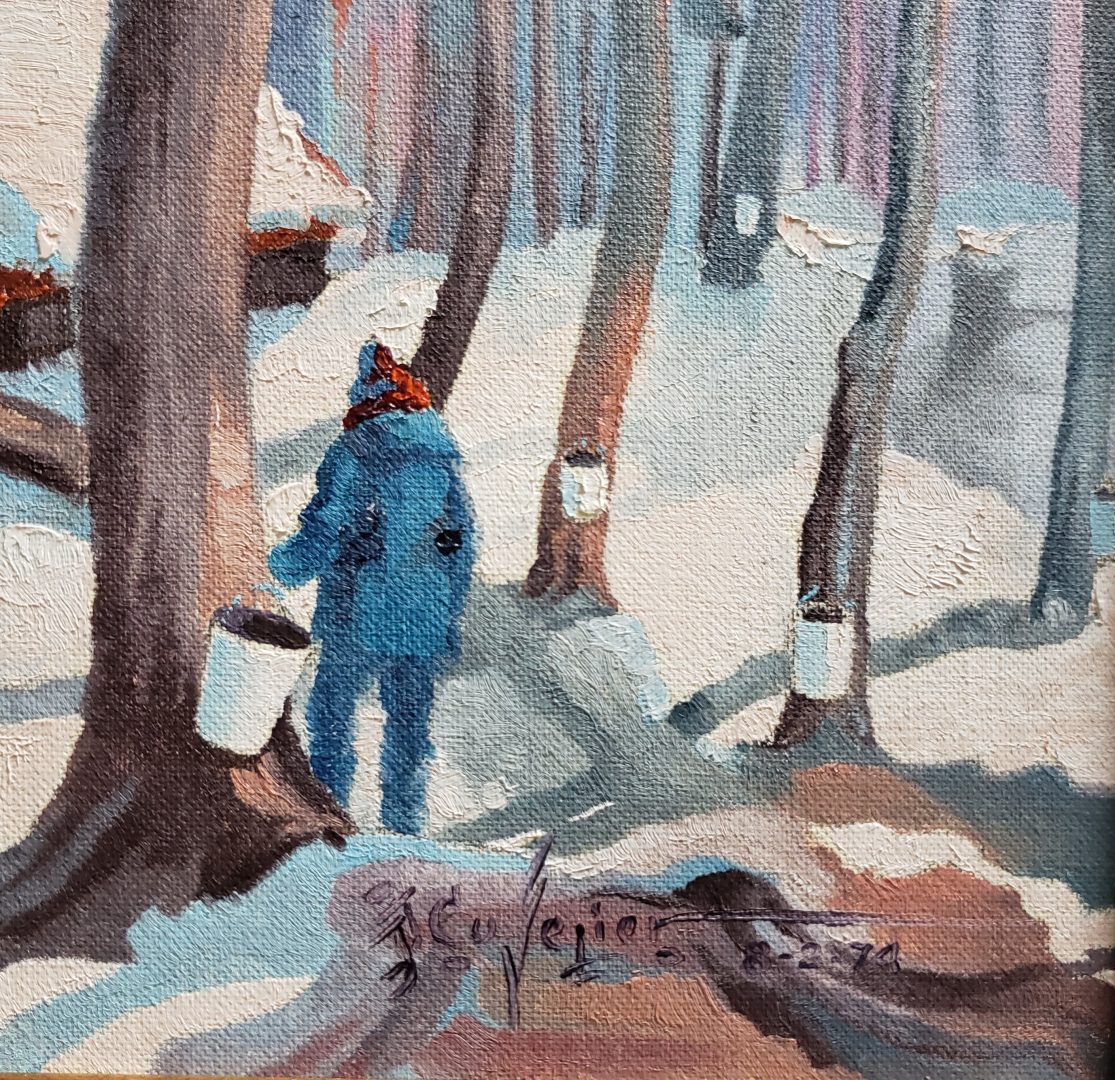This painting is inspired by the awakening of nature at the start of spring, when the sap from the maple trees, first discovered by chance and then ingeniously exploited by the First Nations communities of Eastern Canada, proves to be a much-appreciated resource. Their ways of doing things have been passed down; the custom is now firmly rooted among Quebecers to treat themselves to an annual visit to the sugar shack to taste this sap, which, when heated, turns into sugar water, then syrup or other delicious products.
As for the artist, Jean-Jacques Cuvelier, he was the son of Albertine Jondot (1880-1951) and Léonce Cuvelier (1874-1959), an artist/painter.
In the 1921 Canadian census for Quebec, Jean-Jacques lived in the Saint-Jacques district of Montreal with his parents, his brother Léonce, and his sister France; Jean-Jacques was 9 years old. Having inherited his father’s artistic talents, it is no surprise that he graduated from the École des Beaux-Arts de Montréal or that he received an award for drawing and painting there, and another for sculpture.
In 1933 and 1934, father and son worked together. In light of the tricentennial of the founding of the city of Trois-Rivières, they joined forces with architects Ernest Denoncourt and Ulric J. Asselin. Based on his father’s drawings, Jean-Jacques sculpted busts of Laviolette, the founder of Trois-Rivières; Pierre Gaultier de Varennes, sieur de La Vérendrye (1685-1749), an explorer; and Benjamin Sulte (1841-1923), a journalist, historian, and federal official, among others.
Once this major project was completed, Jean-Jacques Cuvelier saw his reputation continue to increase. Indeed, in 1936, young people from Jeunesses Patriotes, Jeune-Canada, and Jeunesse libérale nationale entrusted to the artist the contract to sculpt a bust depicting Father Lionel Groulx, copies of which could be marketed as a promotional tool in support of the nationalist work of Father Groulx.
Later, Jean-Jacques Cuvelier also illustrated comic strips that accompanied the legends or historical accounts published in L’Action catholique, L’Éclaireur, Le Canada français, L’Étoile du Nord, Le Bien public, Le Devoir, and other newspapers in the late 1930s. In November 1937, the artist opened an art studio at 864, rue Haut-Boc in Trois-Rivières, where those who were interested in drawing, painting, and sculpture were invited. He also gave lessons there. This studio remained open until 1940.
He was also the one who designed the drawings for the bas-reliefs on the Porte Pacifique-Duplessis built at one of the entrances to the Trois-Rivières exhibition park grounds. The work as such was carried out by Télémaire (sic) Auger, a stonecutter, in 1938.
In 1943, he settled in Quebec City on rue Crémazie with his wife, Gabrielle, who ran a ladies’ hat business. The couple had a daughter named Lyse.
Brother Henri Gingras of the Brothers of Christian Instruction, who published under the pseudonym Guy Laviolette, entrusted him to create the illustrations in his book published in 1954, Histoire du Canada (7e année) – Mon pays.
On September 29, 1957, and November 9, 1958, for the column written by Rolland Dumais, author of Regardons la nature vivre, the newspaper Le Soleil illustrated his words with watercolours from Jean-Jacques Cuvelier depicting a moose for one and an owl for the other. The adventure continued with other drawings until December 1960.
In 1963, the little family moved to avenue Cartier in Quebec City.
To commemorate the fifth anniversary of the death of politician Maurice L. Duplessis (1890-1959), the Société des Amis de Maurice L. Duplessis entrusted Jean-Jacques Cuvelier with the mandate to sculpt the monument in memory of the Premier of Quebec and Member of Parliament for Trois-Rivières. The city’s civil and religious authorities would unveil this monument, which was installed on the land adjacent to the Manoir de Niverville, on September 6, 1964.
Then, in 1966, Jean-Jacques, the artist, his wife, and their daughter, Lyse, lived on avenue des Seigneurs in Sainte-Foy (now Quebec City). In 1970, J. J. was said to be a pensioner. They lived at this same address until at least 1975.
The exact date of his death is unknown.
Donation from a collector
Musée Pierre-Boucher Collection
2003 347 P

